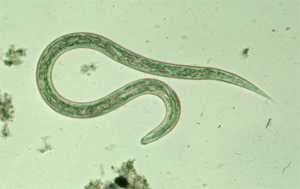The Burden of Hookworm

Filariform (L3) hookworm larva in a wet mount. Credit: DPDx
Hookworm is an intestinal parasite that is part of the family of parasites known as the soil-transmitted helminths (STH). Hookworms affect more than 576 million people across the globe. Left untreated, hookworms cause internal blood loss leading to anemia and malnutrition, particularly in pregnant women and children. Long bouts of hookworm infection in children contribute to problems with physical and mental growth, learning difficulties, and poor school performance. Hookworm has a large economic impact, by significantly reducing a person’s ability to learn in school, earn wages, or support themselves through farming or herding. The infection cannot be transmitted directly from person to person because the worms require some time living in the soil to mature. Hookworm is most commonly transmitted when a person comes into contact with soil contaminated by human feces. The larval worm can penetrate skin and migrate to the intestines where it lives and reproduces.
More on: Hookworm
- Page last reviewed: June 6, 2011
- Page last updated: June 6, 2011
- Content source:


 ShareCompartir
ShareCompartir